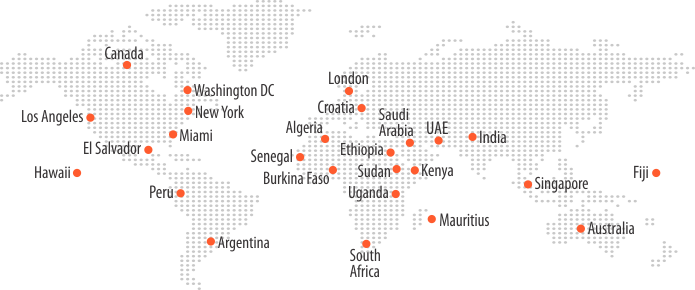The Digital Shift in the Telecom Industry: Challenges and Trends

Digitization is evolving as a fundamental source of systemic transformation in the world. The telecom industry is at the frontlines of this revolution, both as a business ecosystem witnessing substantial change and as a significant promoter of global digitization. As telecom businesses are aware of the benefits that digitalization offers, and 65% already have a plan in place for digital transformation.
With the transition from ISDN (Integrated Services Digital Network) to SIP (Session Initiation Protocol) trunks and Wholesale VoIP services the telecom industry has undergone a massive transformation. As a result, many businesses have maintained their on-premises phone platforms, but cloud-hosted telephony solutions have witnessed significant growth in the last few years.
As breakthrough customer services and products are offered and developed continuously, digital transformation in the telecom industry is a never-ending path. The shift to IP (Internet Protocol) standard will digitally transform all forms of communication, while also laying the groundwork for new cloud services that will help organizations to operate more efficiently.
Major Challenges in the Path of Digital Transformation for Telecom Industry
Traditional digital systems in the telecom business are often centralized and managed via single touchpoints. However, with the adoption of cloud computing, the systems need to be decentralized. As a result, telecom players must consider decentralizing both their external and internal ecosystems for effective digital transformation.
Over the Top (OTT) services are the ancillary telecom services available in the market. In the current market context, these services are critical to achieving meaningful digitization. If not handled appropriately, the seamless adoption of these functionalities will suffer a significant impediment.
New-age telecom networks, such as 5G, promise to provide a broader range of services to a wider group of users. Therefore, with the growing number of subscribers, the advent of new services, and personalized and integrated communication solutions, operational processes are likely to become more complex. The telecom industry should look forward to upgrading services such as initial configuration, customer assistance, troubleshooting, and billing to tackle these complexities. This not only increases operational costs in terms of newer technologies but also necessitates additional resources and training.
The landscape of digital services has been completely transformed by the Internet of Things (IoT) and cloud computing. It has enabled the telecom industry to reach previously unimaginable heights. However, integrating these technologies effectively poses a challenge. Businesses across the world must figure out how to leverage new technology to improve existing processes and systems. Finding investors to procure these costly solutions can also be difficult. Although, the benefits of adopting both IoT and cloud are significant enough to outweigh any reservations that enterprises may have about them.
Digitization Trends in Telecom Industry
Artificial Intelligence (AI)
Since the telecom business is highly dependent on new technologies, many businesses are already implementing AI technologies such as virtual assistants, chatbots, and machine learning tools to enhance customer experience. Artificial intelligence enables operators to make customized offers for their B2C and B2B customers by providing innovative solutions to improve network maintenance, predictive maintenance, and customer service. AI can also identify network faults and safeguard networks from potential frauds.
5G Network
5G is correctly referred to be the cornerstone of digitalization in the telecom industry. This innovative invention wowed investors with its potential for a new tech transformation and enticing rewards. Its network speed is up to 100 times faster than 4G, which is only its fundamental capability, and the integration of computing and storage is widely viewed as its key feature.
Internet of Things
Telecom service providers’ role has changed as the Internet of Things has enabled an improved connection between people and devices. The use of IoT in the telecom industry allows for remote monitoring of base stations and data centers. This minimizes network downtime, improves business procedures, and generates more income.
Telecom businesses are adopting advanced strategies to capitalize on IoT solutions. Business models like SaaS, PaaS, and BaaS are also highly relevant in successful usage of IoT and choose which applications are most valuable for their business.
Robotic Process Automation
Robotic Process Automation (RPA) is used to automate repetitive operations and processes, allowing for more efficiency and agility in analysis and reporting, price tracking, back-office tasks, and customer service. Employees can focus on critical duties while automated technology handles tedious tasks using RPA solutions.
RPA, when integrated with AI processing, helps in automating network optimization to resolve real-time errors with minimal human intervention. It assures a flawless and smooth user experience.
Big Data
With the use of sensors in mobile devices and apps, IoT allows telecom companies to gather massive volumes of data. Companies must make sure that their network can reliably move this data while also supporting emerging technologies.
The obtained data can be used by the telecom industry to provide critical business insights and better understand customer preferences. In the end, the information can be used to enhance customer experience, explore innovative services, and monitor and optimize the network. Companies may use big data to strengthen their operations to stay ahead of the competition.
Cloud Computing
Many telecom companies require large computing systems to deliver a wide range of applications, manage data, and bill services. Moving to the cloud minimizes internal computing resource requirements as well as internal expenses while improving revenue streams.
The pay-per-use service framework enables telecom companies to introduce innovative services, decrease service costs, and operate more efficiently to cater to market demands. The telecom industry is capitalizing on cloud technology by shifting critical business processes to the cloud.
Cyber Security
Telecom industry considers cyber security as a significant aspect of its strategy. With huge customer bases, there are several possibilities for hostile attacks to get illegal access to telecom companies’ data. During the pandemic, cyber-attacks on cloud infrastructure increased by 630%.
If a leading telecom company’s infrastructure is attacked by hackers, it has severe consequences on the telecom brand’s credibility and reliability.
Delivering Strong Customer Experience with Digitization
Traditional telecom customer loyalty and engagement programs often failed to drive long-term customer connections and to create an effective brand impact. Digitization has transformed the scenario by allowing telecom companies to deliver a better customer experience.
A digital transformation strategy must include customer self-service and moving to the cloud helps telecom companies to deliver an omnichannel customer experience. Digitization helps telecom providers to improve every consumer touchpoint, making it easy to subscribe and change services as per customer demands.
Telecom Industry Going Digital – The Way Forward
Businesses face a variety of problems in this fast-paced quest for innovation. These constraints range from software installation issues for internal procedures to the development of meaningful customer solutions. As a telecom company, it is therefore critical to recognize and comprehend these digital transformation obstacles to achieve effective outcomes.
Bankai Group has extensive experience in the telecom industry, enabling companies to become more agile and deliver next-generation services through innovative technological solutions. Our cutting-edge solutions are tailored to market demands and tackle the challenges of transformation initiatives in both network and business sectors. We assist you in managing and executing the digital transformation with the least amount of risk to maximize your returns.
Related Posts
Forecast 2021: What’s Trending In The Telecom Industry
The Global Scenario Of 5G Adoption In Telecom Industry






